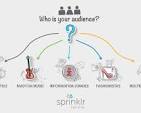Understanding Your Website’s Target Audience: Key Strategies for Success
The Importance of Identifying Your Website’s Target Audience
When it comes to designing and developing a website, one of the most crucial factors to consider is the target audience. Understanding who your website is intended for is essential for creating content, design, and functionality that resonate with your users.
Defining Your Target Audience
Your target audience refers to the specific group of people who are most likely to visit your website and engage with its content. This includes demographics such as age, gender, location, income level, education, interests, and more. By defining your target audience, you can tailor your website to meet their needs and preferences.
Creating User Personas
One effective way to understand your target audience is by creating user personas. User personas are fictional representations of your ideal customers based on real data and research. They help you visualise and empathise with the needs, goals, and behaviours of your target audience.
Customising Content and Design
Once you have identified your target audience and created user personas, you can customise your website’s content and design to appeal to them. This includes using language that resonates with your users, incorporating visuals that speak to their interests, and providing features that enhance their user experience.
Improving User Experience
By understanding your target audience, you can improve the overall user experience of your website. This involves making it easy for users to navigate through the site, find information quickly, and complete desired actions such as making a purchase or submitting a contact form.
Monitoring User Behaviour
Regularly monitoring user behaviour on your website can provide valuable insights into how well you are reaching your target audience. Analyse metrics such as page views, bounce rate, time on page, conversion rate, and more to make informed decisions about improving user engagement.
Conclusion
In conclusion, identifying and understanding your website’s target audience is essential for creating a successful online presence. By tailoring your content, design, and functionality to meet the needs of your users, you can increase engagement, drive conversions, and ultimately achieve your business goals.
8 Essential Tips for Effectively Engaging Your Website’s Target Audience
- Conduct thorough research to understand your target audience demographics, interests, and preferences.
- Create user personas based on your research to represent different segments of your target audience.
- Tailor your website content to address the specific needs and challenges of your target audience.
- Use language and tone that resonate with your target audience to establish a connection with them.
- Ensure that your website design is user-friendly and intuitive for your target audience to navigate easily.
- Optimize your website for mobile devices as many users access websites through smartphones and tablets.
- Collect feedback from your target audience through surveys or analytics tools to improve user experience continuously.
- Regularly review and update your website content and features based on the evolving needs and preferences of your target audience.
Conduct thorough research to understand your target audience demographics, interests, and preferences.
To effectively reach and engage your target audience, it is crucial to conduct thorough research to gain insights into their demographics, interests, and preferences. By understanding factors such as age, gender, location, income level, hobbies, and purchasing behaviour, you can tailor your website content and design to resonate with your audience. This research enables you to create a more personalised and targeted user experience that is more likely to capture the attention and interest of your intended visitors.
Create user personas based on your research to represent different segments of your target audience.
Creating user personas based on thorough research is a valuable strategy to effectively represent different segments of your target audience on your website. By developing detailed and realistic user personas, you can gain deeper insights into the needs, preferences, and behaviours of your target users. These personas serve as guiding profiles that help you tailor your content, design, and functionality to better resonate with each segment of your audience. Ultimately, user personas enable you to create a more personalised and engaging online experience that caters to the specific interests and goals of your diverse user base.
Tailor your website content to address the specific needs and challenges of your target audience.
To effectively engage with your target audience, it is crucial to tailor your website content to address their specific needs and challenges. By understanding the pain points and desires of your users, you can create content that resonates with them on a deeper level. Providing solutions, valuable information, and relevant resources that directly speak to the concerns of your target audience not only enhances user experience but also establishes credibility and trust. This personalised approach fosters a stronger connection with your users and increases the likelihood of achieving your website goals.
Use language and tone that resonate with your target audience to establish a connection with them.
To effectively connect with your target audience, it is crucial to use language and tone that resonate with them. By speaking their language and adopting a tone that aligns with their preferences and values, you can establish a strong connection with your users. This approach not only helps in conveying your message clearly but also creates a sense of understanding and relatability, ultimately fostering trust and engagement with your website visitors.
Ensure that your website design is user-friendly and intuitive for your target audience to navigate easily.
To effectively reach and engage your target audience, it is crucial to ensure that your website design is user-friendly and intuitive. By creating a seamless and easy-to-navigate experience, you can enhance user satisfaction and encourage visitors to explore your content further. Consider the preferences and behaviours of your target audience when designing your website layout, menu structure, and overall user interface to make it effortless for them to find the information they are looking for. A user-friendly design not only improves usability but also contributes to a positive user experience that can lead to increased engagement and conversions on your website.
Optimize your website for mobile devices as many users access websites through smartphones and tablets.
To effectively reach and engage with your target audience, it is crucial to optimise your website for mobile devices. With a significant number of users accessing websites through smartphones and tablets, ensuring that your site is mobile-friendly can enhance the user experience and increase engagement. By implementing responsive design and mobile-friendly features, you can cater to the preferences of mobile users and provide seamless navigation and functionality across different devices. Prioritising mobile optimisation not only improves user satisfaction but also contributes to better visibility and accessibility for your target audience on various platforms.
Collect feedback from your target audience through surveys or analytics tools to improve user experience continuously.
To enhance your website’s user experience and ensure it resonates with your target audience, it is crucial to collect feedback through surveys or analytics tools. By gathering insights directly from your users, you can identify areas for improvement, understand their preferences, and address any pain points they may encounter. Continuous feedback allows you to make informed decisions on refining your website’s content, design, and functionality to better meet the needs and expectations of your target audience, ultimately leading to increased engagement and satisfaction.
Regularly review and update your website content and features based on the evolving needs and preferences of your target audience.
Regularly reviewing and updating your website content and features based on the evolving needs and preferences of your target audience is crucial for maintaining a relevant and engaging online presence. By staying attuned to changes in user behaviour, demographics, and industry trends, you can ensure that your website continues to resonate with your target audience. This proactive approach not only enhances user experience but also demonstrates your commitment to meeting the evolving expectations of your visitors. Keeping your content fresh and aligning features with the preferences of your audience can help drive traffic, improve engagement, and ultimately contribute to the success of your online platform.





